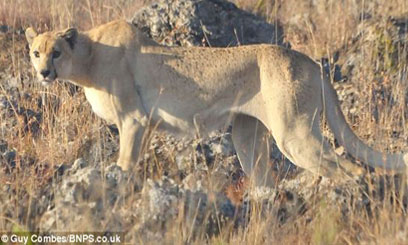For the first time in almost a century a spotless cheetah has been, er, spotted.
The mythical-like creature was discovered by a British wildlife photographer who set out to find it after several reported sightings.
Guy Combes, originally from Shaftesbury, Dorset, scoured 100,000 acres of land in Kenya using a Land Rover and even a plane before he tracked it down.
Guy, 41, got within 50 yards of the unique creature that had a plain sandy coat of fur with hundreds of small freckles on its back and no sign of black spots.
According to experts, the last recorded sighting of a spotless cheetah was in 1921.
And they believe the genetic throwback may actually help the young adult male thrive in the wild as it could be mistaken for a lion.
Guy said: ‘I didn’t think it likely that we would find the cheetah and after three days I gave up and went back to Nairobi.
‘I then got a call saying it had been seen again so I spent another two days searching.
‘It was on the last morning that a pilot who was assisting me spent 45 minutes circling an area so I bombed over to where it was and found the cheetah with its mum that had spots.
Cheetah Facts and Figures
Cheetahs are normally found in most of Africa, as well as parts of the Middle East.
They are well-known for their speed, and can achieve the fastest land speed of any living animal.
Cheetahs can reach speeds of up to 75mph over short bursts, and can accelerate from 0 to just over 60mph in just 3 seconds.
Their conservation status is officially classified as vulnerable, as estimates say there are around 12,400 cheetahs remaining in the wild in 25 African countries.
Namibia has the highest number of cheetahs, with around 2,500, while there are thought to be just 50 or 60 rare Asiatic cheetahs remaining in Iran.
‘Not only was he a staggeringly beautiful animal but I knew that this was a privilege very few other people would ever have.
‘I didn’t expect to see it at all, the area we were going to search was 100,000 acres without borders and he could have easily been beyond that.
‘It was one of the biggest rushes I’ve ever had in my life.
‘He ran off after a while but only when a serval cat appeared and he took off after it.
‘The theory is that the recessive gene that causes the markings, or lack of them, is similar to the phenomenon that causes the markings on the ‘King’ cheetah of South Africa and Zimbabwe.
‘It was pretty exciting to be able to capture the cheetah and still is, as a wildlife artist it’s great and people are quite envious.’
Guy discovered the cheetah at the Athi Kapiti Conservancy in Kenya.
Danny Nineham, a big cat consultant from Gloucestershire said: ‘I haven’t seen a picture like this one before, I would say this cheetah is very rare indeed.
‘To the best of my knowledge and research it was 1921 when a cheetah like this was last seen.
‘The mutant cheetah like any mutant big cat are natural variations that sometimes occur due to spontaneous genetic changes in genes.
‘This colour would help this animal in the wild, as the lion and the puma have this same colour and they survive very well.’
John Pullen, curator of mammals at Marwell Zoo, near Winchester, Hants, said: ‘This is really like a rare skin issue where something has happened to the genetic coding that would give the normal patterning.
‘I haven’t seen a picture like this in cheetahs, every now and again a photo will turn up of an albino or meleanistic animal, more so than this type of coloration issue.
‘This sort of thing is always interesting and personal I love to see these variants that will turn up in the wild.’
(This article has been republished from the Mail Online http://www.dailymail.co.uk/home/index.html)










































